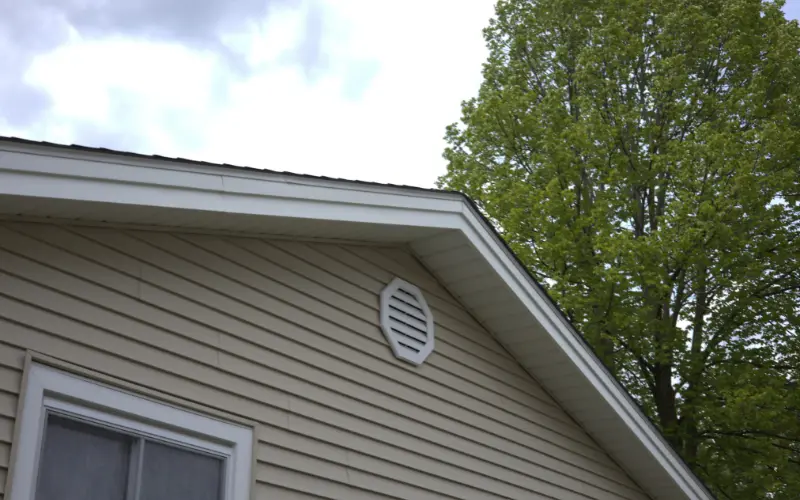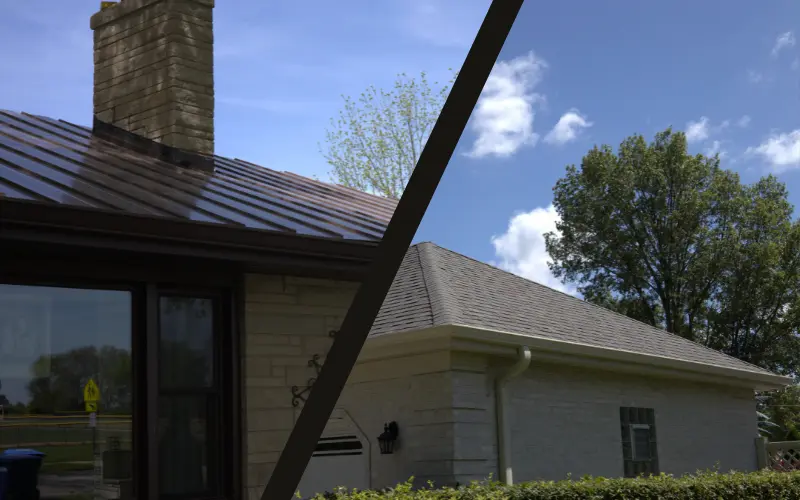Light-colored shingles typically outlast darker ones by reflecting heat and reducing thermal stress. However, shingle longevity depends more on material quality, proper installation, and attic ventilation than color alone. Climate matters too: lighter shingles excel in hot regions, while darker options work fine in cooler areas. Choose premium materials from a qualified roofing company for the best results.
Why Shingle Color During A Roof Replacement Affects
Here's the thing. Asphalt shingles are made with an asphalt-saturated base mat, a layer of adhesive asphalt, and ceramic granules on top. Those granules give the shingle its color and protect the asphalt underneath from UV rays and weather. When dark shingles sit in direct sunlight, they can reach temperatures of 160 to 180 degrees Fahrenheit. Light shingles under the same conditions typically stay 20 to 40 degrees cooler.
Higher temperatures cause the asphalt to soften and harden repeatedly. This thermal cycling breaks down the chemical bonds in the material. Over time, the shingles become brittle, curl at the edges, and lose granules faster. Once granules start washing off in large quantities, the asphalt layer gets exposed to UV radiation and moisture. That's when leaks and failures happen.
.jpeg)
In Northern Illinois, we deal with temperature swings that make this worse. Summer heat followed by freezing winters creates expansion and contraction cycles that stress the shingles. A darker roof absorbs more heat during those 90-degree July days, which compounds the problem. Lighter shingles handle these swings better because they don't get as hot to begin with.
Light Shingles vs. Dark Shingles: The Breakdown
Let's compare what you can expect from each option when it comes to a roof replacement.
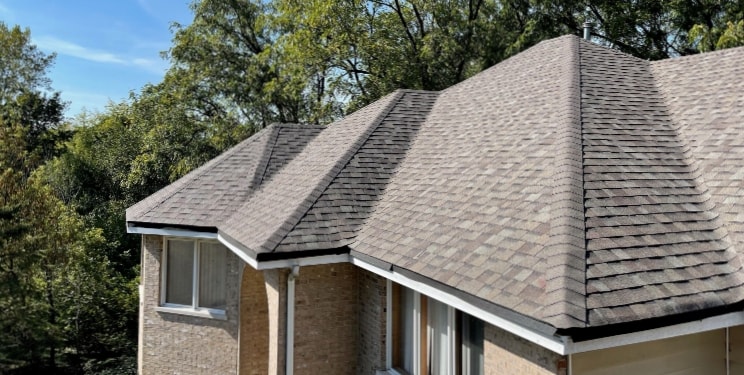
Light-Colored Shingles
- Typical lifespan: 25 to 30 years for architectural shingles, sometimes longer with premium products
- Heat absorption: 20 to 40 degrees cooler than dark shingles on hot days
- Energy efficiency: Lower attic temperatures mean less strain on your air conditioning
- Granule retention: Better over time because less thermal stress
- Common colors: White, light gray, tan, beige, light brown, cream
- Aesthetic concern: May show algae stains more visibly in humid areas (though algae-resistant shingles solve this)
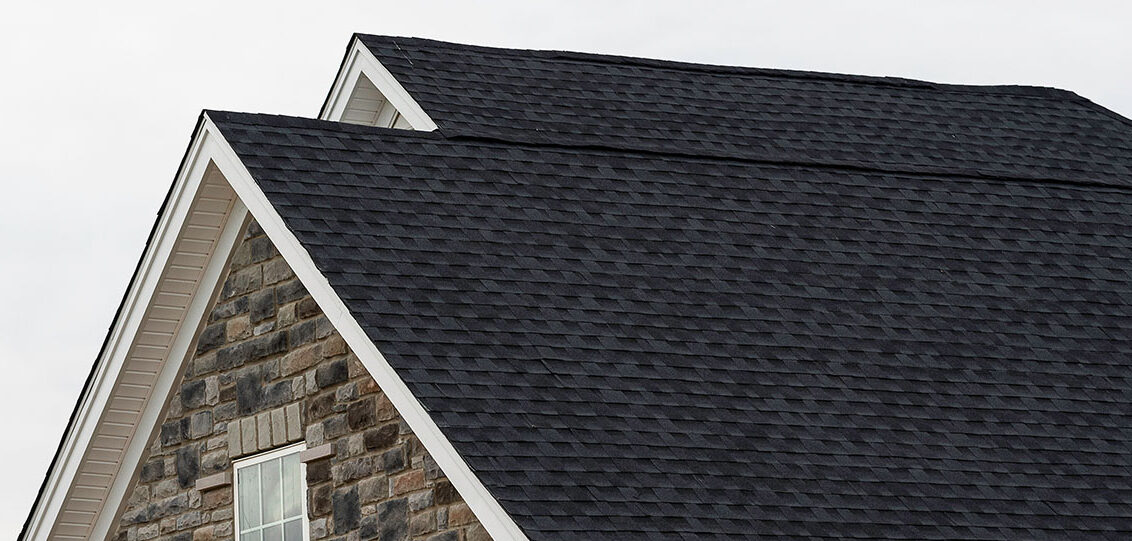
Dark-Colored Shingles
- Typical lifespan: 20 to 25 years for architectural shingles under similar conditions
- Heat absorption: Can exceed 170 degrees in direct summer sunlight
- Energy efficiency: Higher attic temperatures increase cooling costs
- Granule retention: Faster loss due to repeated heating and cooling
- Common colors: Black, charcoal, dark brown, slate gray, dark blue
- Aesthetic benefit: Hides dirt and minor stains better, offers bold curb appeal
The gap isn't huge, but it's real. If you want maximum lifespan from your roof replacement, lighter tones have the edge.
Best Shingle Colors for Northern Illinois Climate
Alright, let's talk about what works in our specific climate. Northern Illinois gets hot, humid summers and cold, snowy winters. We see everything from thunderstorms and hail to ice dams and wind damage. The ideal shingle color balances longevity with practical considerations like energy costs and appearance.
Top choices for longevity:
- Light gray: Reflects heat well, hides minor dirt, complements most home styles
- Tan or sand: Excellent heat reflection, warm appearance, blends with natural surroundings
- Weathered wood tones: Medium-light browns that balance aesthetics and performance
- Off-white or cream: Maximum heat reflection, best lifespan potential, but requires algae-resistant options
Colors to approach carefully:
- Pure black: Highest heat absorption, shortest lifespan in our climate
- Dark charcoal: Looks sharp but expect faster granule loss
- Deep brown: Better than black, but still runs hotter than lighter options
Here's a real consideration for Northern Illinois homeowners. Our summers hit 85 to 95 degrees regularly, but we also get brutal winters. A lighter roof helps with cooling costs in summer, but some people worry about heat loss in winter. The truth is that your attic insulation handles winter heat retention, not your shingle color. The shingles are an exterior layer. Focus on proper insulation (R-38 to R-60 in attics for our climate) and ventilation, and the color becomes a smaller factor for heating costs.
Energy efficiency studies (done in places like Texas and California, but the physics apply here too) show that light-colored roofs can reduce cooling costs by 10 to 15 percent in summer. In Northern Illinois, where cooling season is shorter than in southern states, you're looking at savings of maybe $75 to $150 per year. Not a fortune, but it adds up over the 25-year life of your roof replacement.
Other Factors That Affect Shingle Lifespan
Color matters, but it's not the only thing. When you're working with a roofing company on a replacement project, these factors actually have more impact on how long your new roof lasts.
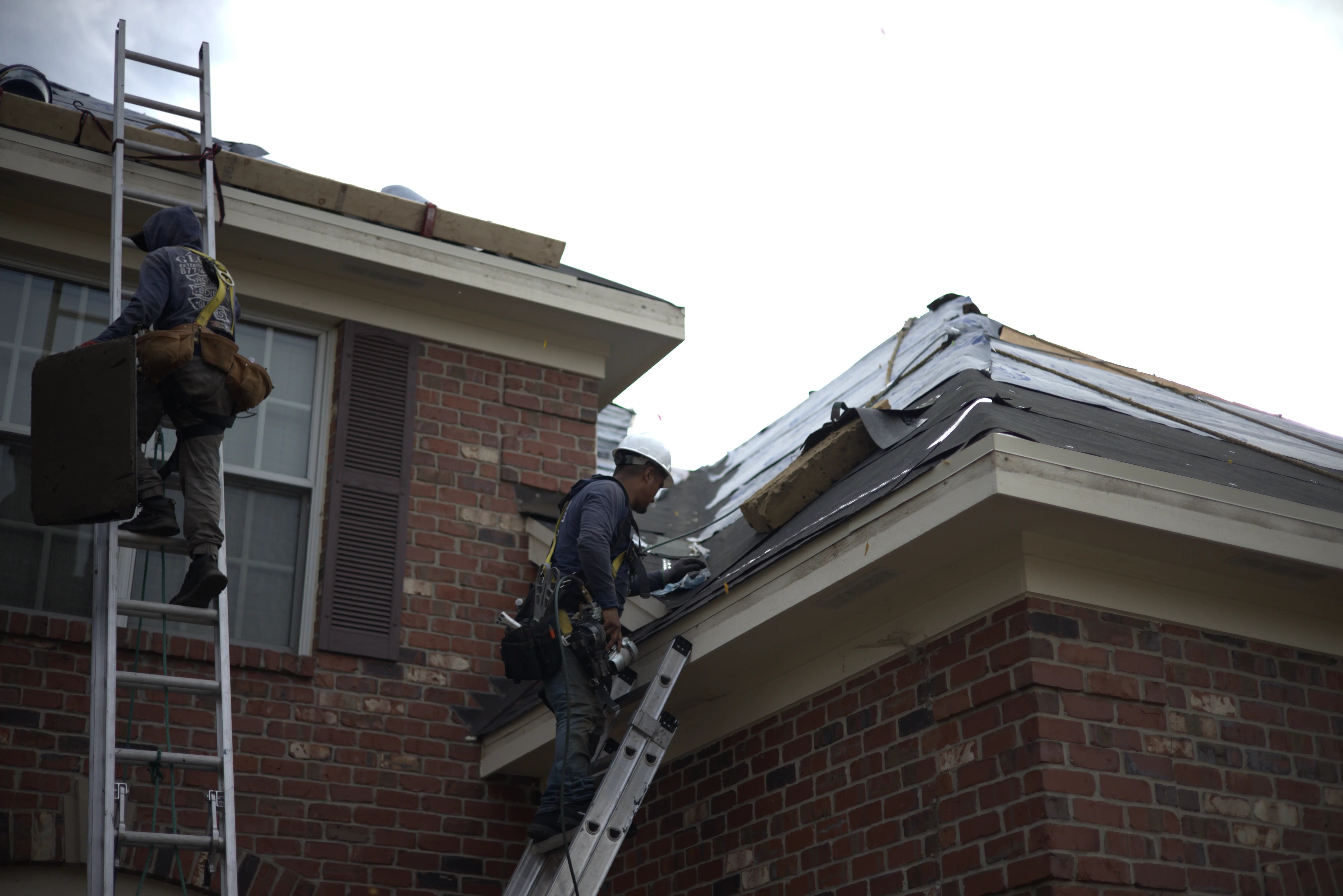
Roof Pitch and Sun Exposure
A steep roof sheds water faster and tends to last longer than a low-slope roof. Also, the south-facing side of your roof takes the most sun exposure and heat throughout the day. That side will age faster regardless of color. North-facing slopes stay cooler and often look newer for years after the south side starts showing wear.
Ventilation Quality
Poor attic ventilation traps heat and moisture under the roof deck. This cooks your shingles from below and causes premature failure. Proper ridge vents, soffit vents, and balanced airflow can add 5 to 10 years to any roof. If a roofing company quotes you a roof replacement without checking ventilation, that's a red flag.
Installation Quality
Shingles nailed too high, too low, or with the wrong fasteners will fail early no matter what color they are. Proper starter strips, drip edge, underlayment, and flashing all matter. A quality roofing company should follow manufacturer specs exactly. Cutting corners here costs you years of life.
Tree Coverage
Shade from large trees keeps your roof cooler, which is good. But branches scraping shingles, leaves holding moisture, and debris in valleys can cause damage. If your home sits under heavy tree cover in areas like Elgin, Rockford, or Lake County, regular roof cleaning and trimming become essential maintenance tasks.
Hail and Storm Damage
Northern Illinois sees its share of severe weather. A single hailstorm can shorten your roof's life by years even if the damage isn't immediately visible. After major storms, get an inspection. Small impacts add up and compromise the granule layer.
Material Quality Matters More Than Color
This is where things get interesting. You can have the lightest color shingle available, but if it's a cheap three-tab shingle with poor granule adhesion, it won't outlast a quality dark architectural shingle with good materials.
When you're comparing options for a roof replacement, look at these material factors:
Shingle weight and thickness: Heavier shingles (250+ pounds per square) typically have more asphalt and better granule coatings. They cost more but last longer.
Warranty coverage: Look at the actual coverage terms, not just the number. A "30-year warranty" often means 10 years of full coverage, then prorated. Compare the full coverage period.
Impact resistance: Class 4 impact-rated shingles resist hail damage better. They cost 10 to 20 percent more but can save you from an early replacement after a storm. Some insurance companies in Illinois offer discounts for Class 4 shingles (check with your agent).
Algae resistance: Copper or zinc granules prevent black streaks. This matters more for light-colored roofs where stains show up. Most quality shingles now include this feature.
Brand reputation: Major manufacturers (GAF, Owens Corning, CertainTeed, IKO) have better quality control than no-name brands. A good roofing company will explain the differences and let you see samples.
For Northern Illinois homeowners, the sweet spot is usually a mid-range to upper-range architectural shingle in a light to medium color. You get good longevity without paying for features you don't need. Expect materials to run $90 to $150 per square (100 square feet) for decent quality. Premium designer shingles can hit $200 to $300 per square, but the longevity gain doesn't always justify the cost unless aesthetics are a priority.
Cost Considerations for Roof Replacement in Northern Illinois
Of course, none of this comes free. Here's what a roof replacement actually costs in our area and how color factors into the price.
Average roof replacement costs (Northern Illinois, 2025):
- Small home (1,200 to 1,500 sq ft): $6,000 to $9,500
- Medium home (1,800 to 2,200 sq ft): $8,500 to $14,000
- Large home (2,500 to 3,000 sq ft): $12,000 to $20,000+
These ranges assume mid-grade architectural shingles, full tear-off, and standard complexity. Prices vary based on roof pitch, number of penetrations (chimneys, skylights, vents), and accessibility.
Color's impact on cost: Generally minimal. Light and dark shingles from the same product line cost about the same. Some specialty colors (designer blues, greens, or premium blends) might add 5 to 10 percent to material costs, but that's more about style than light versus dark.
Where color affects cost is in long-term energy savings and lifespan. A light-colored roof that lasts 28 years instead of 23 years effectively reduces your annual cost of ownership. The upfront price is identical, but you get more value over time.
What drives up replacement costs:
- Multiple layers of old shingles to remove (adds $1,000 to $2,500)
- Roof deck repairs from water damage or rot (varies widely, $500 to $5,000+)
- Complex roof shapes with lots of valleys and angles
- Steep pitch requiring extra safety equipment
- Premium underlayment or ice/water shield
- Upgrades to ventilation systems
When you're getting quotes from a roofing company, make sure they break out material costs, labor, tearoff, disposal, and any extras. A single lump sum makes it hard to compare bids or understand what you're actually paying for.
When to Replace Your Roof (Color Aside)
Knowing when to pull the trigger on a roof replacement is just as important as choosing the right color. Here's what to watch for.
Clear signs you need replacement:
- Shingles are curling, cracking, or missing in multiple areas
- Large sections of granules are gone (the roof looks darker or patchy)
- Daylight visible through roof boards from inside the attic
- Sagging areas on the roof surface
- Repeated leaks in different locations
- The roof is 20+ years old and starting to show wear
Warning signs to monitor:
- Algae or moss growth (doesn't always mean replacement, but check for moisture issues)
- Loose or damaged flashing around chimneys, vents, and valleys
- Granules collecting in gutters (normal in small amounts, concerning if heavy)
- Neighbors with similar homes all getting replacements (if your homes were built at the same time)
For Northern Illinois homes, most asphalt shingle roofs hit the replacement point between 20 and 28 years. If your roof is approaching 20 years and you're starting to see issues, don't wait. Water damage from a failing roof costs far more to fix than a proactive replacement.
Timing matters too. Spring and fall are the best seasons for roof work in our climate. Summer is busy and hot (which is fine but not ideal for workers or materials). Winter work is possible but complicated and often more expensive. Plan ahead if you can.
Choosing the Right Roofing Company for Your Replacement
Color choice matters, but who installs your roof matters more. A quality roofing company makes the difference between a 20-year roof and a 30-year roof regardless of what color you pick.
What to look for:
- Proper Illinois licensing and insurance (liability and workers' comp)
- Local references from recent projects, ideally in your area
- Written estimates that detail materials, labor, timeline, and warranty terms
- Willingness to explain options without high-pressure sales tactics
- Clear communication about project timeline and weather delays
- Manufacturer certifications (GAF Master Elite, Owens Corning Preferred, etc.)
Red flags to avoid:
- Requires large deposits upfront (standard is 10 to 30 percent)
- Pushes you to make a decision immediately
- Can't provide proof of insurance
- Offers a price significantly lower than other bids (usually means shortcuts)
- Won't put warranty terms in writing
- Plans to leave old shingles in place without good reason
In Northern Illinois, roof replacement projects typically take 1 to 3 days for most homes once work begins. Weather can extend this timeline. A professional roofing company will protect your home with tarps if rain interrupts work and will complete proper cleanup afterward.
Ask about their waste disposal process. A full roof tear-off generates 2 to 4 tons of debris. Reputable companies haul this away and dispose of it properly. You shouldn't be left with a dumpster in your driveway for weeks or a pile of shingles in your yard.
Does Color Affect Resale Value?
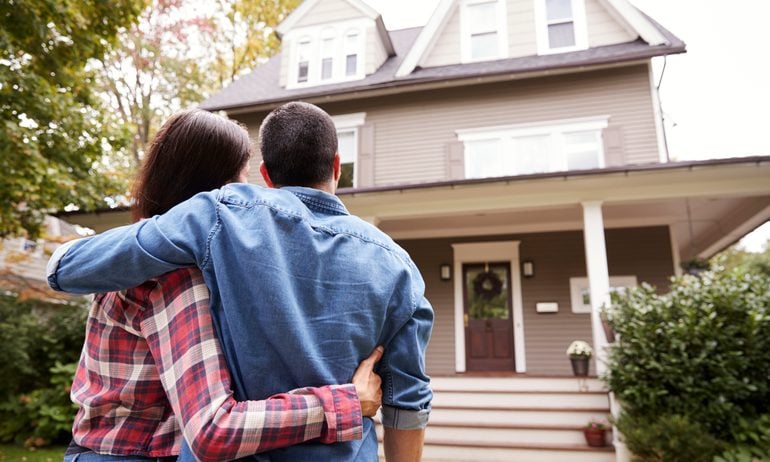
Quick aside here. If you're planning to sell your home in the next few years, roof color can influence buyer perception. Light and neutral colors (gray, tan, brown, weathered wood tones) appeal to the widest range of buyers. Bold colors like red, blue, or green are polarizing. They might look great to you but could turn off potential buyers who would have to replace the roof to get the color they want.
That said, a roof replacement itself is a strong selling point regardless of color. Homes with new roofs in Northern Illinois typically sell faster and for better prices. A quality roof signals that the home has been maintained and removes a major expense from the buyer's near-term budget.
Real estate agents in the Chicago suburbs and surrounding areas consistently rank roof condition as one of the top features buyers evaluate. A 20-year-old roof in rough shape can knock $10,000 to $15,000 off your asking price or lose you the sale entirely. A new roof in a neutral color is basically a free marketing tool.
How to Maximize Any Roof's Lifespan
Alright, you've picked your color and completed your roof replacement. Here's how to make sure it lasts as long as possible.
Annual maintenance checklist:
- Clean gutters and downspouts in spring and fall
- Trim overhanging branches to prevent debris buildup and damage
- Check for loose or damaged shingles after major storms
- Look for signs of ice dams in winter and address ventilation issues
- Remove heavy snow loads if accumulation exceeds 2 feet (use a roof rake from the ground)
- Inspect flashing around chimneys, vents, and skylights
Every 3 to 5 years:
- Have a professional roofing company do a detailed inspection
- Clean any algae, moss, or lichen growth (use gentle methods, not pressure washing)
- Check attic ventilation and make improvements if needed
- Verify that all penetrations and seals remain watertight
Proper maintenance can add 5 to 8 years to any roof. It also helps you catch small problems before they become expensive repairs. For example, one loose shingle is a $100 fix. Ignoring that loose shingle until water gets under it and rots the deck becomes a $2,000 to $5,000 problem.
In Northern Illinois, pay special attention to ice dam prevention. Adequate attic insulation and ventilation prevent the freeze-thaw cycles that cause ice dams along the eaves. Once ice dams form, they can force water under shingles and into your home. Light or dark doesn't matter if ice is lifting your shingles.
The Bottom Line on Shingle Color and Longevity
So, what color shingles last the longest? Light colors win, but the margin is smaller than you might think. Light-colored shingles typically outlast dark shingles by 2 to 5 years due to lower heat absorption and reduced thermal stress. In Northern Illinois, where we experience temperature extremes, this advantage can be even more pronounced on south and west-facing roof sections.
However, color is just one variable in a complex equation. When you're planning a roof replacement, focus on:
- Choosing quality materials from reputable manufacturers
- Working with an experienced roofing company that follows proper installation procedures
- Ensuring adequate attic ventilation and insulation
- Maintaining your roof with regular inspections and minor repairs
- Considering your home's specific exposure, pitch, and environmental factors
If longevity is your top priority and you have no strong aesthetic preferences, go with light gray, tan, or weathered wood tones. These colors offer the best balance of heat reflection, universal appeal, and practicality for Northern Illinois homes.
If you love the look of darker shingles, don't let the longevity difference stop you. A high-quality dark shingle properly installed and maintained will still give you 20 to 25 years of reliable service. That's a solid return on investment.
What to Consider Next
Before you commit to a roof replacement, take these steps:
- Get three estimates from licensed roofing companies in Northern Illinois. Compare not just price but also proposed materials, warranty coverage, and project approach.
- Request shingle samples in the colors you're considering. See them against your home's siding in different lighting conditions. What looks great in a brochure might not work with your exterior.
- Check your attic for proper ventilation and insulation. Address these issues during your roof replacement if needed. It's much easier and cheaper to upgrade ventilation when the old roof is already off.
- Review your homeowner's insurance to see if they offer discounts for impact-resistant shingles or other upgrades. The savings might offset the higher material cost.
- Plan your timing for spring or fall if possible. You'll likely get better scheduling flexibility and avoid extreme weather delays.
- Ask about warranties for both materials and labor. Understand what's covered, for how long, and what actions might void the coverage.
Your roof is one of the largest investments you'll make in your home. Take the time to understand your options, choose quality materials in a color that serves your goals, and work with a roofing company you trust. A well-planned roof replacement should give you decades of protection and peace of mind, regardless of whether you go light or dark.

.webp)

